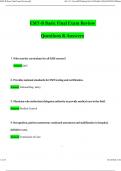EMT-B Basic Final Exam Review.pdf file:///C:/Users/HP/Desktop/New%20folder%20(4)/EMT-B%20Basic
EMT-B Basic Final Exam Review
Questions & Answers
1. Who sets the curriculum for all EMS courses?
Answer DOT
2. Provides national standards for EMT testing and certification.
Answer National Reg- istery
3. Physician who authorizes/delegates authority to provide medical care in the field.
Answer Medical Control
4. Recognition, patient assesment, continued assesment and stabilization in hospital,
definitive care.
Answer Continuum of Care
1/
1 of 23 10/24/2024, 8:02
,EMT-B Basic Final Exam Review.pdf file:///C:/Users/HP/Desktop/New%20folder%20(4)/EMT-B%20Basic
5. Types of stress include
Answer Cumulative, post-traumatic stress reaction, eustruss, acute stress, and chronic stress
6. S/S of stress include
Answer Increased respiratory rate, heart rate, and B/P, va- sodilation, dialted pupils, tensed
muscles, increased glucose levels, perspiration, deacreased blood flow to gastrointestinal tract,
irritability, inability to concentrate, difficult or increased sleeping, anxiety, guilt, loss of
appetite, decreased sexual activity, loss of interest in work, alcholism, drug use.
7. Management of stress includes
Answer Eliminate stressors, change partners, get rid of negative personalities, change work
hours, reduce overtime, change your attitude, don't obsess over what you can't change, excercise,
diet.
8. Fight or Flight response
Answer During an acute stress response, the autonomic nervous system is activated and the
body increases level of cotricol, adrenilen, and other hormones that produce an increased heart
rate, quick breathing, and higher BP. Blood is shunted from extremities to the big muscles to
2/
2 of 23 10/24/2024, 8:02
,EMT-B Basic Final Exam Review.pdf file:///C:/Users/HP/Desktop/New%20folder%20(4)/EMT-B%20Basic
"fight or flight".
9. Routes of transmission include
Answer Direct - touch or droplets Indirect - spread by inanimate objects
Mechanical (vector born) - by insects
Biological - Transmissions by which the germs live or grow Airborne -
sneezes, coughs
Dust - may carry pores, may remain for long periods.
10. Control and prevention of contamination include?
Answer Hand washing, gloves, eye protection, gowns, masks, mask, respirators, barrier
devices, and immuniza- tions.
11. Duty to Act is?
Answer An obligation to provide care.
12. Duties include
Answer Duty to
3/
3 of 23 10/24/2024, 8:02




